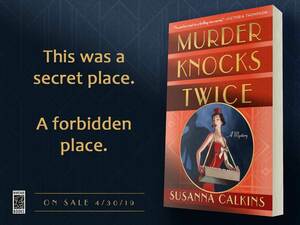 There's a funny thing about persistence that writers often talk about. We talk about continuing despite the odds, mustering up the courage to keep writing even when things get hard, just pushing on even when the outcome is not known. This is what I felt with MURDER KNOCKS TWICE, and how moving it has been for me to see this book out in the world. The journey of MURDER KNOCKS TWICE began about nine years ago. I was still querying--unsuccessfully--what would become the first novel in my new series--A MURDER AT ROSAMUND'S GATE. I kept getting rejected by agents, and I thought, 'Maybe I need to set aside this seventeenth-century novel, and try my hand at something different." (For the more complete journey of the first series, check out my post in HOW IT HAPPENED on the Thrill Begins). Even though I'm a British historian by training, for many years I've been teaching a graduate course on the History and Philosophy of Higher Education. On several occasions, I had found my way to the amazing archives at my university, and I began to think about setting my book on a college campus (much like mine) in 1930 Chicago. I was interested in college rituals and the role of the first women in college. I wrote about 200 pages of this book, which featured a young Egyptian woman named Shani, and her sidekick gum-cracking roommate Gina Ricci. I thought, this is going to be my new thing. My new historic period, my new world. But then, an interesting thing happened. That seventeenth-century novel ended up selling, and I ended up writing four books in that series (and will have a fifth out next year). So I set aside my 1930s Chicago novel, and it went in the DRAWER. But then, a few years ago, when my publisher asked me about a new series, I came back to that drawer and made an interesting discovery. The sidekick roommate was really the star of the book, and I moved her out of college, and into a West side Chicago speakeasy. Most of those 200 pages were scrapped, but the idea of the story remained. I wrote the first part without a contract, and then it was picked up. So there's a lesson in there, for me at least, about persisting even when the outcome is not known. The persistence was helped by loving the world that I was creating for my characters. I mean, speakeasies....cocktails....murder...?
4 Comments
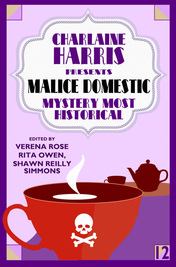 I'm so thrilled that my very first short story--The Trial of Madame Pelletier-- was selected for inclusion in Malice Domestic 12: Mystery Most Historical (Wildside Press, 2017). Like my Lucy Campion novels set in 17th century England, this short story stemmed from research I did in graduate school a zillion years ago. (And yeah, that's pretty fun for me to get to use another chunk of this doctoral research in a new way!) I won't say too much about my story other than it features the trial of a presumed poisoner in a small town in France, in 1840. The trial was a cause celebre--a trial of the century--which played out as much in the court of public opinion and in sensationalized newspaper accounts, as it did in the assize court in Limousin. I remember being struck too, not just be the trial itself, but how the woman at the heart of it--the Lady Poisoner--was being tried both as a criminal and as a female. While my story differs dramatically from the trial that inspired it, I did want to convey that same sense of a woman being tried on many levels. Moreover, ever since I read Agatha Christie's Witness for the Prosecution, I have wanted to try my hand at a courtroom drama. So this was such a fun piece for me to write overall. I'm really excited to read the other stories in the volume!!! The selected stories are:
"A One-Pipe Problem" by John Betancourt "The Trial of Madame Pelletier" by Susanna Calkins "Eating Crow" by Carla Coupe "The Lady's Maid Vanishes" by Susan Daly "Judge Lu's Ming Dynasty Case Files-The Unseen Opponent" by P.A. De Voe "Honest John Finds a Way" by Michael Dell "Spirited Death" by Carole Nelson Douglas "The Corpse Candle" by Martin Edwards "Mistress Threadneedle's Quest" by Kathy Lynn Emerson "The Black Hand" by Peter Hayes "Crim Con" by Nancy Herriman "Hand of an Angry God" by KB Inglee "The Barter" by Su Kopil "Tredegar Murders" by Vivian Lawry "The Tragic Death of Mrs. Edna Fogg" by Edith Maxwell "A Butler is Born" by Catriona McPherson "Home Front Homicide" by Liz Milliron "He Done Her Wrong" by Kathryn O'Sullivan "Summons for a Dead Girl" by K.B. Owen "Mr. Nakamura's Garden" by Valerie O Patterson "The Velvet Slippers" by Keenan Powell "The Blackness Before Me" by Mindy Quigley "Death on the Dueling Grounds" by Verena Rose "You Always Hurt the One You Love" by Shawn Reilly Simmons "Night and Fog" by Marcia Talley "The Measured Chest" by Mark Thielman "The Killing Game" by Victoria Thompson "The Cottage" by Charles Todd "The Seven" by Elaine Viets "Strong Enough" by Georgia Wilson The Tranformative 1910s--a lesser known era. A guest post by debut novelist Radha Vatsal...6/13/2016 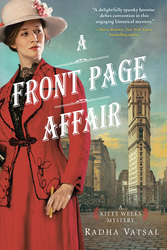 I invited debut novelist Radha Vatsal on my blog today, to share how she came to pick the 1910s as the backdrop for her Kitty Weeks historical mysteries. Now that I've got a little summer reading time ahead of me, I'm definitely looking forward to diving into this new series....I think Kitty and Lucy, my printer's apprentice, would have enjoyed hanging out!!! 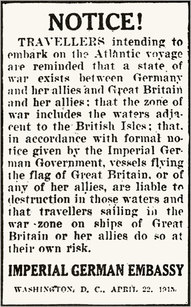 1915 Warning from German Embassy 1915 Warning from German Embassy The first season of Downton Abbey ends in August 1914 with Lord Grantham announcing at a country party that World War I has begun. (Or rather, that England was at war with Germany—since no one knew just yet what kind of war it would become.) While we tend to associate World War I with Europe and think that America’s involvement in it was short-lived and only began when the US joined the fighting in 1917, life in the United States changed dramatically between 1914-1918, which is why it seemed a perfect era in which to set a mystery series. I find that so many people know about the “Gilded Age,” the period from about the 1870s to the 1900s with its fabulous wealth and “Robber Baron” businessmen. Through novels like The Great Gatsby, we’re also very familiar with the 1920s Jazz Era. But the period in between, the 1910s, remain largely uncharted in popular fiction and film—and so much happened then. The US went from a second-tier nation to the economically most powerful and culturally dominant country in the world. Women went from second-class citizens to finally winning the right to vote. Much of what we associate with modern life—cars, movies, even national boundaries—took their current form during that period. It was a transformative moment in history, which is why I explore it through the eyes of the protagonist of A Front Page Affair, Capability “Kitty” Weeks, a young woman journalist based in New York City. A Front Page Affair, the first in the Kitty Weeks mystery series, takes place during the summer of 1915, in the aftermath of the sinking of the Lusitania and an attack on financier, J.P. Morgan. As the series unfolds, Kitty will confront the many social and political changes taking place in America in the course of her investigations.  Radha Vatsal grew up in Mumbai, India, and came to the United States to attend boarding school when she was sixteen. She has stayed here ever since. Her fascination with the 1910s began when she studied women filmmakers and action-film heroines of silent cinema at Duke University, where she earned her Ph.D. from the English Department. A Front Page Affair is her first novel. You can email her directly at: radhavatsalauthor (at) gmail (dot) com. You can also connect with her on Tumblr, Facebook and Goodreads
 Qumran (Source: Israel National Parks) Qumran (Source: Israel National Parks) Research is such a Siren… Okay, I’ve never lashed my body to a mast and filled my ears with beeswax before firing up the laptop (in the old days, it was easier to build dramatic tension if you were striding up the stairs toward the wooden doors guarding the entrance to your local library, like hometown cousins of Scylla and Charybdis), but I have thrown myself off a cliff into the adventure of discovery – sometimes just for the sake of learning! I’m not talking about looking for relevant statistics for Professor Cudlip’s “Theory of Infinity” course, either. I’m talking about feeling the burn in your frontal lobes, counting your pulse up to 200-plus beats per minute, experiencing the joys of carpopedal spasms. There’s something forbidden, even illicit, about digging into history. You might know where you will start your explorations, but you have no idea where you will end up. Perhaps I’m a voyeur by nature…or an eavesdropper…or just a busybody, but the headlines of 2016 (ISIS, Republicans, North Korea, Wall Street), in my opinion, pale beside the questions lurking in the shadows of history (Did Oswald act alone? Did FDR know the Japanese plans to bomb Pearl Harbor? Did Stalin poison Lenin?) Or perhaps I’m a conspiracy theorist… I know for sure that I am a schizophrenic. I must be…I write under two names. M. A. Richards is the author of a spy novel series featuring Nathan Monsarrat, a former deep cover operative with the CIA – the first novel, CHOICE OF ENEMIES, launched in January 2016 while the second offering, A THOUSAND ENEMIES, will be available in November 2016 (both published by Sunbury Press). I also scribe historical fiction as A. M. ben Yitzhak. Currently, I’m conducting research on the Zealots, the group of breakaway radicals who fled Jerusalem during the Roman rule of the Second Temple Period to live a more pure life in the barren Judean wilderness…and fought the Empire to a standstill from 66 to 132 AD, when the last of the Zealots, led by Shimon bar Kochba, bled to death in the desert south of the Dead Sea. To conduct historical research on a secretive group that lived two thousand years ago demands familiarity with the writings of the period…so, you need (1) access to the original materials (if you ever ask the Israel Museum to borrow the original – not digital - Dead Sea Scrolls for a few days, you’ll hear a really rich laugh) and (2) you need to read Latin, Accadian, Aramaic, and a few other “dead” languages. I suppose you could trust someone else’s translations, but then you are dependent on someone else… There is another roadblock, which might be a blessing, the more I think about it: so few original texts were written two thousand years ago. I can rely on the aforementioned Dead Sea Scrolls, Josephus, and other apocryphal writings (e.g., the minor prophets), but the scholarship of this period is severely limited and, unless you’re on a first name basis with the Witch of Endor, it would be tough to interview Judas of Gamala, Simon bar Giora, Menahem ben Judah or any of the other original kana’im and siqari’im – the founders of the Zealots. A third difficulty refers back to the opening of this epic…research is such a Siren! It’s addictive! Impossible to stop! I can’t tell you how many times I shut down the stacks in local and university libraries. At least, the internet never sleeps, but unless you induct your spouse into the Eleusinian Mysteries, chances are good that the time you spend researching the daily habits of the Zealots will do nothing for your marriage and family life. Faced with so many challenges, what’s a historical novelist to do (and I’m not talking about agents and editors shaking their heads and informing you that the market for Zealot fiction is incredibly, infinitesimally tiny)? Travel! Read the State Department warnings…and ignore them. Listen to your family and friends…and ignore them. Read the newspapers and watch the twenty-four cable stations…and ignore them! You wanna write about the Zealots? Go to their home. Stomp around their ancient stomping grounds. You probably will not discover a missing cache of Dead Sea Scrolls in the unexplored caves of Qumran, but you will absorb the zeitgeist of the period as you stumble over sandstone boulders, tread on red desert poppies, and quaff liter after liter of tepid water beneath the broiling desert sun. You don’t have to go the fully Monty, either…you can sleep not in a tent beneath clear, star filled skies but in an air conditioned hostel that offers hot showers and a fantastic breakfast of yoghurt, cheese, olives, bread, fruit, and vegetables. After a few weeks of following in the footsteps of the Zealots, you will have collected enough ambiance to fill the pages of a historical novel and a wonderful appreciation for the amenities of the twenty-first century. When you’re back home, having made amends with your spouse, family, and employer, when you’re sitting in front of your laptop with English translations of Josephus and the Dead Sea Scrolls piled on your desk, when you launch your fingers against the monolithic blank digital page…you will always have your best ally by your side: your imagination. After all – it’s not history. It’s historical fiction.  M. A. Richards is the author of the Nathan Monsarrat international espionage novels. Born in Lowell, Massachusetts, he received his Bachelor of Arts degree in Theater Studies from Connecticut College and his Master of Arts degree in English from the University of Massachusetts at Amherst. During a career as a Cultural Attaché in the Department of State that spanned more than two decades, he served in Baghdad, Jerusalem, Lagos, Moscow, Seoul, Tel Aviv, and Washington, D.C. He also served at U.S. Pacific Command in Honolulu as the Special Advisor to the Commander. He speaks Arabic, Hebrew, Korean, and Russian. M. A. divides his time between Palm Beach and Tel Aviv, where he indulges his passions for motorcycles, photography, and archaeology. Visit www.MARichardsBooks.com to learn more about M. A. Richards and CHOICE OF ENEMIES. 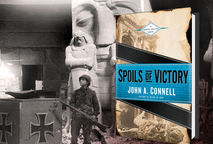 credit: http://johnaconnell.com/ credit: http://johnaconnell.com/ The Brothers Grimm meet the Nazis? I'm delighted to have John A. Connell join me on my blog today. Here, he describes how a small city in Germany served as the dramatic backdrop for SPOILS OF VICTORY, his latest crime thriller set during the post-World War II era. The dark layered history of this small city is truly fascinating... 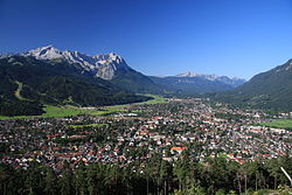 Garmisch-Partenkirchen Garmisch-Partenkirchen Garmisch-Partenkirchen would seem like an unlikely place to set SPOILS OF VICTORY, my latest crime thriller about murder and organized crime in post-WW2 Germany. The small German city—or large town, depending on how you look at it—could have been the setting for a fairytale in some far-off land. Nestled in a valley of the Bavarian Alps, its streets are graced with Hansel-and-Gretel houses and buildings with frescoes of pastoral scenes or local saints. Partenkirchen, first mentioned in 15A.D., was originally a Roman settlement, and one of its main streets still follows the old Roman trade route between Venice and Augsburg. Garmisch was settled 800 years later by a Germanic tribe. Separated by the glacier-fed Partnach river, the two towns remained separate until Hitler forced them to unite in 1935. Garmisch (as it is commonly called—much to the chagrin of the people of Partenkirchen) has been a favored winter resort since the late 1800s. The highest mountain in Germany is there, and the entire region is crisscrossed by world-famous ski slopes and dotted with placid alpine lakes. Hardly a promising location for murder and mayhem. 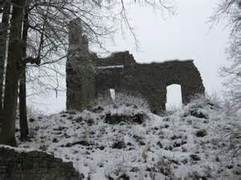 Werdenfels Castle...haunted? Werdenfels Castle...haunted? On the surface, that is, as Garmisch-Partenkirchen has had several dark periods. The first came in the 1600s, when the importance of overland trade routes dried up, causing Garmisch-Partenkirchen to come to near ruin. Privation, plagues, and crops failures led to witch-hunts, and in one two-year period 10% of the meager population was burned at the stake or garroted. Legend has it that Werdenfels castle, where the “witches” were imprisoned and executed, was so haunted that it was abandoned and torn down to build a church to drive away the evil that lurked within its walls. An even darker period descended on Garmisch with the Nazis’ rise to power. Göring went there to be treated for a bullet wound after Hitler’s failed putsch and given honorary citizen status by the city’s leaders. Hitler had wanted to buy farmland there for his mountain retreat, but the farmer wouldn’t sell, and Adolf ended up building his Eagle’s Nest in Berchtesgaden; a veritable who’s who of Nazis had called Garmisch their home away from home. The vestiges of the 1936 Winter Olympics still stand as monuments to Hitler’s dream of a 1000-year empire, though gone are the Nazi banners and signs forbidding Jews, or the elite Gebirgsjäger soldiers and swastika flag-waving fanatics. Indeed, it was a past so sordid that the town only commissioned it's archives in 1972—the people had no interest in remembering their Nazi past. 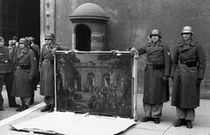 German soldiers of the Hermann Göring Division posing in front of Palazzo Venezia in Rome in 1944 German soldiers of the Hermann Göring Division posing in front of Palazzo Venezia in Rome in 1944 So, why did I decide on Garmisch-Partenkirchen for murder and mayhem? It was really by serendipity. My protagonist, Mason Collins, was actually the villain in a previous, defunct novel, with him committing murder in order to steal a cache of Nazi gold in occupied Germany. It was when I began researching Mason’s murderous backstory that I discovered that after WW2 the charming and beautiful Garmisch-Partenkirchen had become the Dodge City of occupied Germany! When the Third Reich collapsed, and the Allied armies were pushing into Germany from the west and east, Garmisch-Partenkirchen became the stem of the funnel for fleeing wealthy Germans, Nazi government officials and war criminals, retreating SS, and former French Vichy and Mussolini officials. And for the same reason it also became the final destination for Nazi-stolen art masterpieces, vast reserves of the Third Reich gold, currencies, precious gems, penicillin, diamonds, uranium from the failed atomic bomb experiments. After the war, all that became available for purchase on the black market. With millions of dollars to be made, murder, extortion, bribes and corruption became the norm. The promise of fortunes also brought in a multitude of scoundrels, scam artists, and gangsters. Add to this, tens of thousands of bored US Army soldiers ripe for temptation. The black market thrived, and gangs of deserted allied soldiers, former POWs, ex-Nazis, and corrupt displaced persons roamed the countryside. With the U.S. officials looking the other way or profiting from the activity, some gangs operated so openly that they were more like import-export companies. Here was this fantastic contrast: a Brothers Grimm fairytale town behind whose charming facades lurked mayhem and murder. It is said that truth is stranger than fiction, and, in this case, it has proved true. I even left some of the crazier stories out just to make seem more “real!” So, as it turns out, Garmisch-Partenkirchen was a great setting for a historical crime thriller after all! 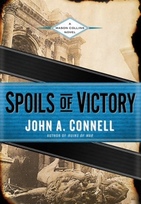 From the official blurb: From the author of Ruins of War comes an electrifying novel featuring U.S. Army criminal investigator Mason Collins, set in the chaos of post-World War II Germany. When the Third Reich collapsed, the small town Garmisch-Partenkirchen became the home of fleeing war criminals, making it the final depository for the Nazis’ stolen riches. There are fortunes to be made on the black market. Murder, extortion, and corruption have become the norm. It’s a perfect storm for a criminal investigator like Mason Collins, who must investigate a shadowy labyrinth of co-conspirators including former SS and Gestapo officers, U.S. Army OSS officers, and liberated Polish POWs. As both witnesses and evidence begin disappearing, it becomes obvious that someone on high is pulling strings to stifle the investigation—and that Mason must feel his way in the darkness if he is going to find out who in town has the most to gain—and the most to lose…  John A. Connell is the author of Ruins of War and SPOILS OF VICTORY, the first two books in the Mason Collins series. He was born in Atlanta, where he earned a BA in Anthropology, and has been a jazz pianist, a stock boy in a brassiere factory, a machinist, repairer of newspaper racks, and a printing-press operator. He has worked as a cameraman on films such as Jurassic Park and Thelma & Louise and on TV shows including The Practice and NYPD Blue. He now lives with his wife in Madrid, Spain, where he is at work on his third Mason Collins novel. Visit him online at johnconnellauthor.com.  I'm thrilled to be joined today by Alison McMahan, author of The Saffron Crocus, a Young Adult novel set in 17th century Venice. From the synopsis: Venice, 1643. Isabella, fifteen, longs to sing in Monteverdi’s Choir, but only boys (and castrati) can do that. Her singing teacher, Margherita, introduces her to a new wonder: opera! Then Isabella finds Margherita murdered. Now people keep trying to kill Margherita’s handsome rogue of a son, Rafaele. Was Margherita killed so someone could steal her saffron business? Or was it a disgruntled lover, as Margherita—unbeknownst to Isabella—was one of Venice’s wealthiest courtesans? Or will Isabella and Rafaele find the answer deep in Margherita's past, buried in the Jewish Ghetto? Isabella has to solve the mystery of the Saffron Crocus before Rafaele hangs for a murder he didn’t commit, though she fears the truth will drive her and the man she loves irrevocably apart. 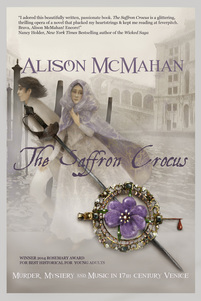 Sometimes readers ask me why I set my YA historical mystery/romance novel in Venice in 1643. Why 1643? Most novels set in Venice are set during its heyday, from the 1300s to the 1500s. Or they are set in Vivaldi's Venice of the 18th century. Or they are set in the 19th century, mirroring the society Henry James setting in novels like Wings of the Dove. But the 17th century in Venice doesn't get much love. Venice was in decline, in between its period of grandeur and the invasion by the Ottoman Turks and Napoleon. Periods of decline are historically just as interesting as periods of greatness. There is much we can learn from them. I picked 1643 Venice for seven special reasons: 1. THE BLACK DEATH. In 1630 Venice, and the rest of what we now call northern Italy, was hit by the Bubonic Plague. Eighty thousand lives were lost in just seventeen months in Venice laone. On the 9th of November, for example, five hundred and ninety-five died. These enormous fatalities greatly affected the city. Even the Doge, Nicolò Contarini passed away. I wanted my heroine, Isabella, to have lost her parents at the age of five to the plague, and to be fifteen at the time the story begins, so the date of the of the story had to be 1643. 2. THE BIRTH OF OPERA. Yes, I know most teens consider opera to be uncool at best, unmentionable at worst. But I'm an opera fan, so there's a little bit of "write what you know" here, and I was hoping that my own love of opera would communicate itself through the pages. The word "opera" itself is an Italian word – it means "labor" or "work" in Italian. Opera originated in Italy when courtiers decided they preferred the "intermezzi," the light-hearted singing and dancing interludes that broke up heavy Roman plays, to the plays themselves. Opera evolved from these Intermezzi. The first complete opera, "Euridice" by Jacopo Peri was performed in Florence in 1600. 3. MONTEVERDI: If, like me, you are a fan of what the human voice can do in song, then you are a fan of Monteverdi. At the time the story of The Saffron Crocus takes place, Monteverdi was the musical director of the chorus of San Marco's Basilica. Because I admire his music so much, I wanted to give him a small role. My heroine wants to sing for the chorus, but only boys can do that, and she uses various ruses to get what she wants, which pits her against Monteverdi. 4. LOST OPERAS: There is something so romantic about lost works of art. Of course, in the 1600s, opera performances weren't recorded. But the scores were written down. You'd think it would be easy enough to keep a score, and copy it over when you need to. But one of the world's greatest operas, L'Arianna, is a lost opera. All we have is one recitative from it, "Arianna's lament," which plays a key role in my story. 5. CASTRATI: Castrati were male singers who were castrated before puberty to keep their voice artificially high. In other words, the baroque world was so opposed to women singing that they preferred to castrate little boys (only a lucky few survived the procedure) rather than let women perform. I was fascinated both by castrati themselves – what were their lives like? And enraged by the idea that Venetian society would prefer to go that far rather than let women sing. A key character in the story is a castrati. 6. CONCERTO DELLE DONNE (consort of ladies). Women could sing in private homes. This practice started after Alfonso II, Duke of Ferrara, who established the first group of "amateur" singers to perform for him. They were considered "amateur" because they were women and could not perform professionally (that is, for pay), but in fact they were renowned for their technical and artistic virtuosity. I know professional musicians today who have tried to re-create some of their music and couldn't do it. My heroine sings in salons before she finds a way to sing professionally. 7. THE JEWISH GHETTO: The Jewish Ghetto in Venice was not the first, but it is where we get the name. The English term "ghetto" is an Italian loanword, which actually comes from the Venetian word "ghèto", slag, and was used in this sense in a reference to a foundry where slag was stored located on the same island as the area of Jewish confinement. I have always been fascinated by how the Jews lived in Venice, and almost half of the book takes place there. I could go on and on about what was special about Venice in 1643, as Venice is endlessly fascinating, but I'll stop there. Read the book, or better yet, listen to some of this music, preferably in Venice itself! Alison McMahan chased footage for her documentaries through jungles in Honduras and Cambodia, favelas in Brazil and racetracks in the U.S. She brings the same sense of adventure to her award-winning books of historical mystery and romantic adventure for teens and adults. Her latest publication is The Saffron Crocus, a historical mystery for young. Murder, Mystery & Music in 17th Century Venice. She loves hearing from readers. Feel free to check out her website, visit her on instagram, pinterest, tumblr, or on Facebook, or just send her a tweet! Her books can be found at Black Opal Books, AMAZON US; AMAZON UK.
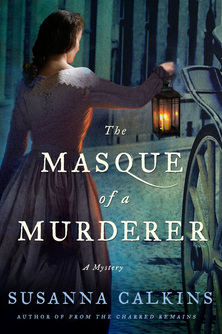 I'm so happy and honored to say that my third historical novel, The Masque of a Murderer, officially launches today, April 14! And while I may not be quite as giddy when my first novel, A Murder at Rosamund's Gate (2013) launched two years ago--because nothing can ever compare to the release of a first novel--I'm still as loopy as I was last year, when From the Charred Remains (2014) entered the world. Recently, in preparation for the launch, I've been answering a lot of fun and interesting questions about The Masque of a Murderer (the historical background, the story and characters, and my writing process etc). So, I thought I'd do a quick round-up here! I welcome you to:
Thanks so much for sharing this journey with me!!! And I appreciate all the bloggers and reviewers who hosted me, including those through Amy Bruno's Historical Fiction Virtual Blog Tours! And I'm always so grateful to the wonderful people at Minotaur, especially Kelley Ragland and Elizabeth Lacks, and my agent David Hale Smith, and of course my wonderful alpha reader, Matt Kelley!! (and now, I turn my attention back to A DEATH ALONG THE RIVER FLEET, due out April 2016!!!!)  I'm delighted to say that recently a group of us--eight authors who write historical mysteries--joined together to form a new collective: Sleuths in Time, Tracking Crime. We write historical mysteries set in England, Scotland and the United States, ranging in time from the 1660s to the 1930s. Connect with us on Facebook and Pinterest (Sleuths in Time Authors) or follow us on Twitter! (@sleuthsintime). We've got some great things planned, including some giveaways and a scavenger hunt at Malice Domestic. Stay tuned for details!
|
Susanna CalkinsHistorian. Mystery writer. Researcher. Teacher. Occasional blogger. Categories
All
Archives
May 2023
|
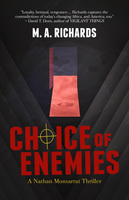
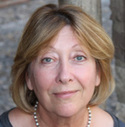
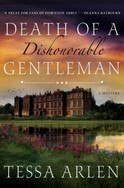

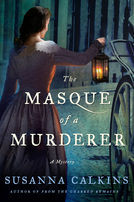

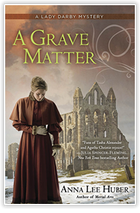

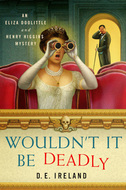

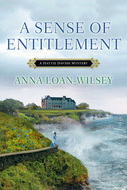
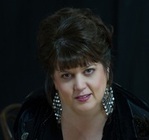
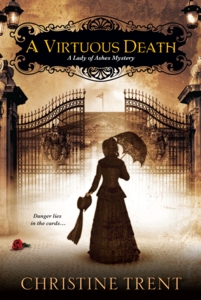

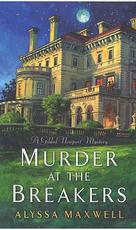

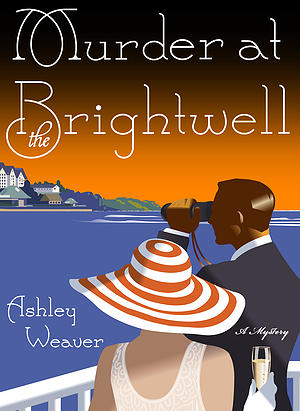
 RSS Feed
RSS Feed